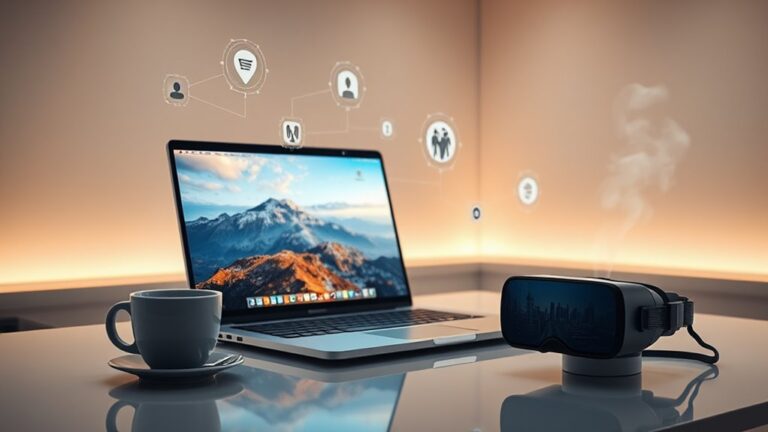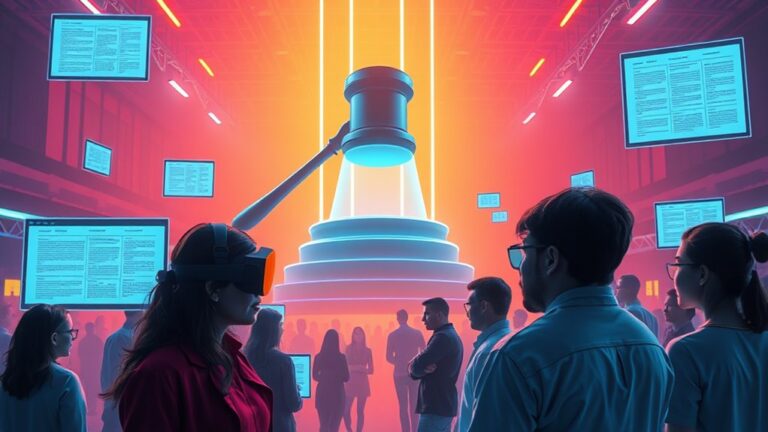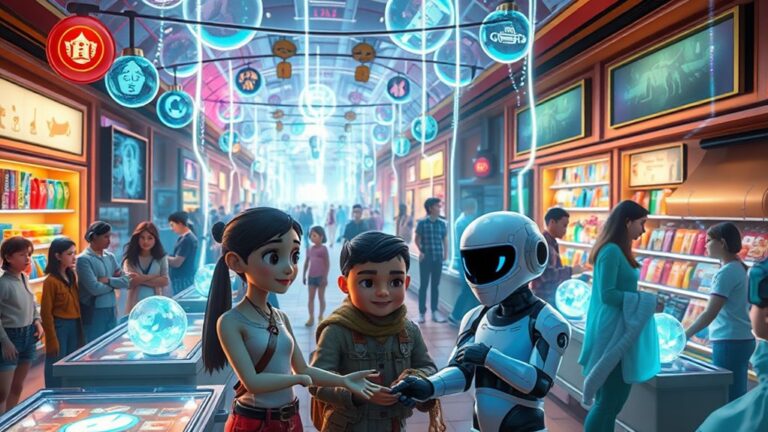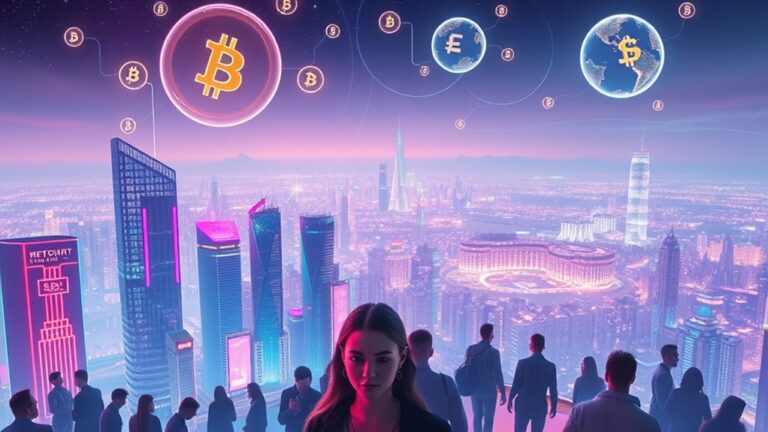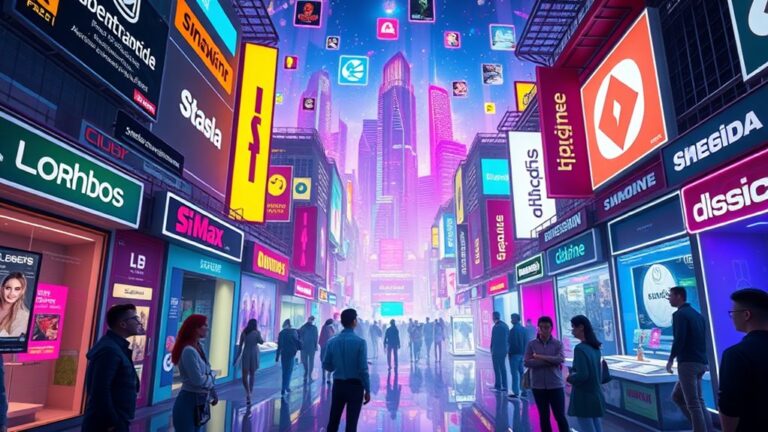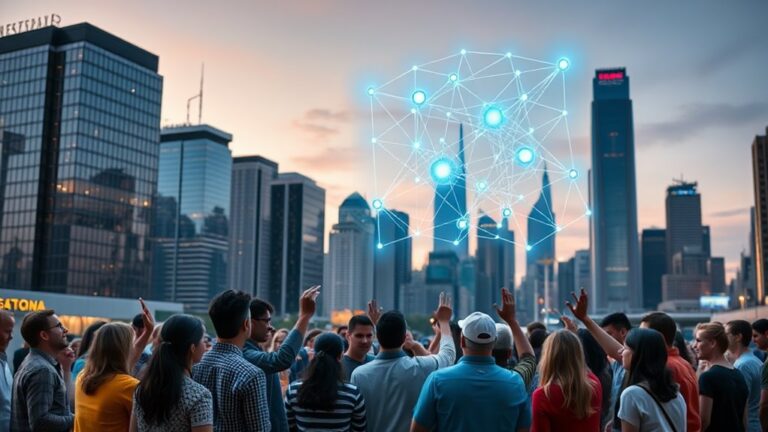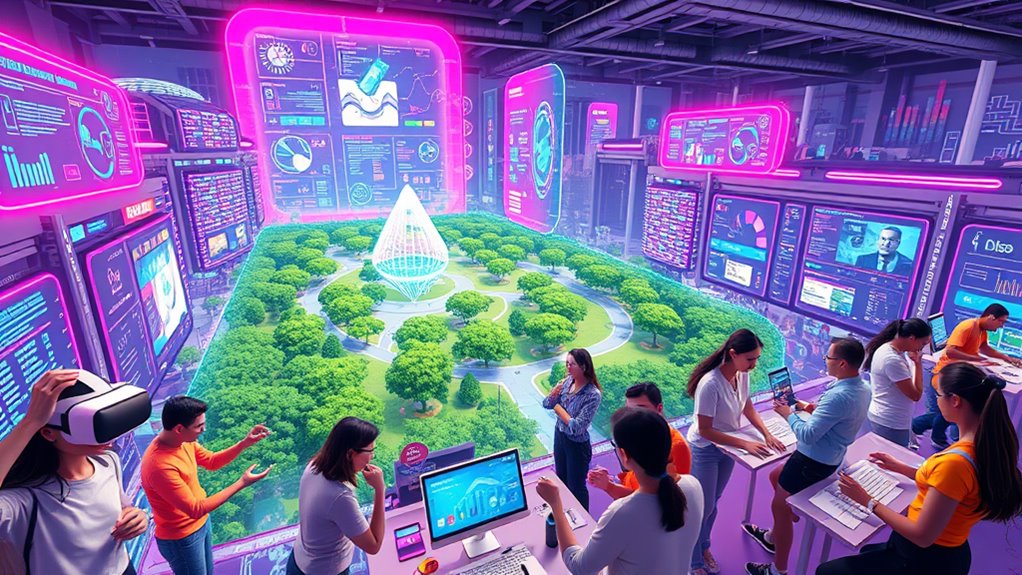
The Future of Work in the Metaverse: What Changes Can We Expect?
The future of work in the metaverse will introduce flexible digital environments that enhance collaboration and accessibility. Key technologies, such as VR, AR, and blockchain, will transform traditional workspaces, creating immersive experiences. New job opportunities will arise, requiring skills in development, cybersecurity, and storytelling. Companies will focus on inclusivity through customizable avatars and tailored onboarding. While the metaverse offers economic growth potential, challenges such as environmental impact and security must be addressed. Further exploration reveals more about these changes.
Key Takeaways
- The metaverse will enable flexible, customizable virtual workspaces, reducing real estate costs and enhancing global collaboration.
- Emerging job roles in the metaverse will require skills in AR/VR development, cybersecurity, and blockchain technology.
- Immersive technologies will foster employee engagement and a more inclusive workplace culture through customizable avatars and interactive environments.
- Virtual offices may lower carbon footprints while addressing e-waste and promoting sustainability initiatives in the digital economy.
- Effective collaboration tools and real-time feedback mechanisms will reshape team interactions and enhance productivity in the metaverse.
Technological Advancements in the Metaverse
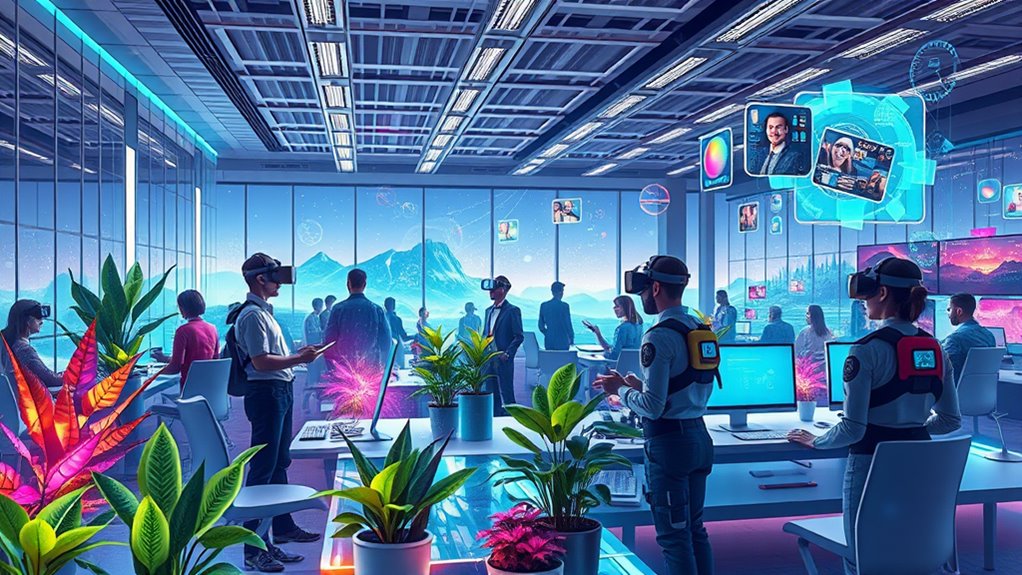
As the concept of the metaverse continues to evolve, various technological advancements are playing a crucial role in shaping its future.
Key technologies such as Virtual Reality (VR) and Augmented Reality (AR) enable immersive experiences that enhance social interactions and task performance. Artificial Intelligence (AI) personalizes user experiences, while 5G network infrastructure guarantees high-speed communication necessary for real-time interactions.
Key technologies like VR, AR, and AI are revolutionizing user experiences and interactions in the evolving metaverse.
3D modeling creates detailed virtual environments, supporting engagement. Emerging trends like edge computing reduce latency, improving user experiences, while blockchain technology allows for secure data management. Furthermore, the integration of cryptocurrencies for secure transactions within the metaverse is essential for establishing new economic models and ensuring transparency.
Additionally, advancements in XR hardware enhance interaction, and AI-powered tools streamline processes. Together, these technologies pave the way for a more integrated and dynamic metaverse, transforming how individuals connect and collaborate.
Transforming Traditional Workspaces

The transformation of traditional workspaces in the metaverse represents a significant shift in how employees collaborate and interact. Virtual environments allow for flexible, scalable workspaces that can mimic physical offices or create entirely new designs. This transformation leads to reduced real estate costs and increased accessibility, enabling global talent collaboration without geographic limitations.
| Aspect | Traditional Workspaces |
|---|---|
| Office Design | Fixed physical locations |
| Cost | High real estate expenses |
| Accessibility | Limited to local talent |
| Collaboration Tools | Basic communication methods |
Additionally, immersive technologies enhance employee engagement and foster a diverse workplace culture. The metaverse encourages open communication and supports hybrid work models, promoting a more inclusive and collaborative work environment.
New Job Opportunities in a Virtual World
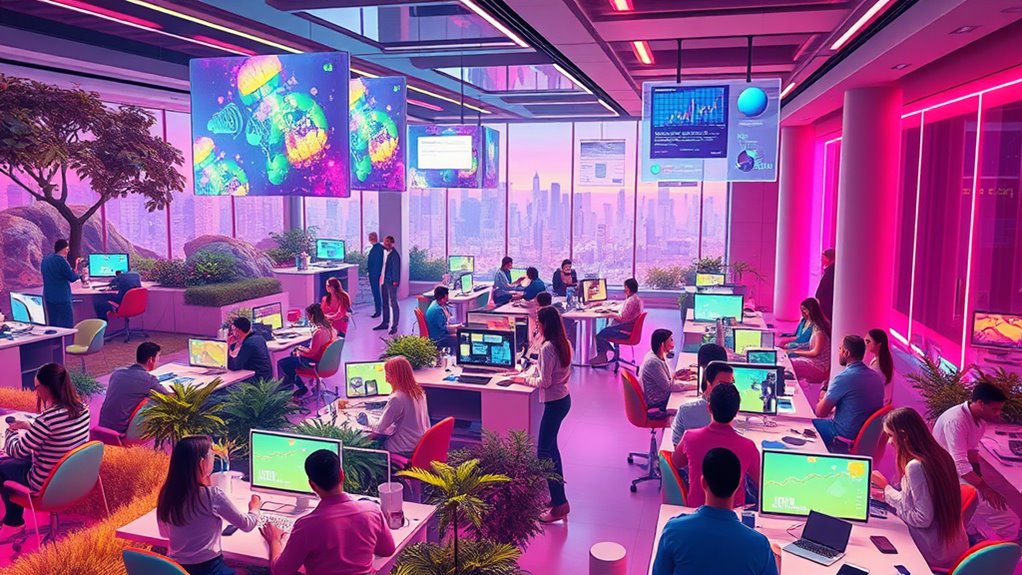
New job opportunities in the metaverse are rapidly emerging, reflecting the evolving landscape of work in virtual environments. Roles such as AR/VR developers and 3D game developers are critical, as they create immersive experiences that engage users.
In addition, metaverse cybersecurity experts are essential for protecting digital spaces from threats. Blockchain developers are focusing on integrating blockchain technology for secure transactions, while storytellers craft narratives that enhance user experiences.
Skills required for these positions include technical proficiency in programming and 3D modeling, alongside creative abilities in design. Moreover, professionals should possess data analysis, marketing knowledge, and collaboration skills to succeed.
The demand for these roles spans various industries, particularly technology, gaming, and marketing, highlighting the metaverse’s growing significance in the job market.
Creating Inclusive Work Environments
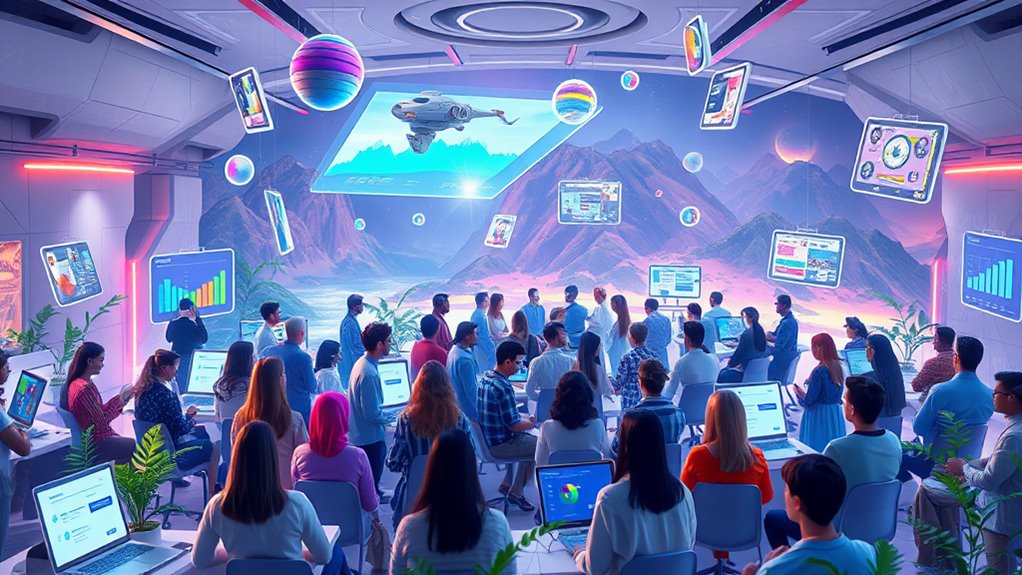
Creating inclusive work environments in the metaverse involves addressing global hiring opportunities and customizing employee experiences to meet diverse needs.
As organizations expand their reach, they must also confront inclusion challenges that may arise from varying cultural backgrounds and accessibility requirements.
Global Hiring Opportunities
As organizations increasingly explore the potential of the metaverse, global hiring opportunities are expanding, particularly in creating inclusive work environments.
The metaverse allows for customizable avatars, which can minimize appearance-based biases and foster a sense of belonging among diverse employees.
With companies like ABB and Nexans leading metaverse hiring, the mining industry alone has experienced a 53% compound annual growth rate in related job postings.
The United States dominates this market with a 28% share, followed by Canada and France.
Additionally, 47% of employees are open to using avatars in meetings, highlighting a shift toward more inclusive participation.
As organizations adopt hybrid models, the metaverse emerges as a viable platform for global collaboration and inclusivity.
Employee Experience Customization
In the evolving landscape of work, employee experience customization has emerged as an essential component for fostering inclusive work environments.
The metaverse enables tailored virtual spaces that cater to diverse roles, enhancing collaboration and productivity. Personalized onboarding processes alleviate anxiety for new hires, while customizable avatars allow employees to express their identities freely.
Additionally, virtual workspaces can be adjusted for individual preferences, such as lighting and temperature, promoting comfort and satisfaction. The metaverse also offers equal participation for employees globally, creating accessible environments for individuals with disabilities.
This inclusive approach reduces barriers to collaboration and encourages diversity, resulting in a more cohesive workforce. Ultimately, employee experience customization in the metaverse contributes greatly to a welcoming and engaging workplace.
Inclusion Challenges Ahead
While the metaverse presents significant opportunities for creating inclusive work environments, it also poses several challenges that organizations must navigate. Accessibility concerns, such as the high costs of VR equipment, can limit equitable access. Additionally, ensuring compliance with regulations in virtual spaces remains complex.
| Challenges | Considerations |
|---|---|
| Accessibility Concerns | High VR equipment costs |
| Harassment and Safety | Risks of virtual harassment |
| Legal Frameworks | Need for updated policies |
Organizations must also address data security and monitor behaviors to maintain a safe environment. As they adapt to this new landscape, prioritizing ethical governance and training will be essential to foster inclusivity in virtual workplaces.
Economic and Environmental Impacts of the Metaverse

The Metaverse is poised to have significant economic and environmental impacts, shaping both the digital landscape and real-world interactions.
Economically, it could contribute up to 2.8% to global GDP in the next decade, with a market size potentially reaching $3 trillion. This digital economy will enable the creation, buying, and selling of digital goods, leading to job creation, though some traditional roles may be automated.
Environmentally, increased energy consumption from VR and AR devices poses challenges, but virtual offices could reduce the need for physical spaces, lowering carbon footprints. Additionally, improved resource optimization may mitigate travel needs.
Addressing e-waste and promoting sustainability initiatives will be essential to balance these impacts effectively.
Enhancing Collaboration Through Mixed Reality
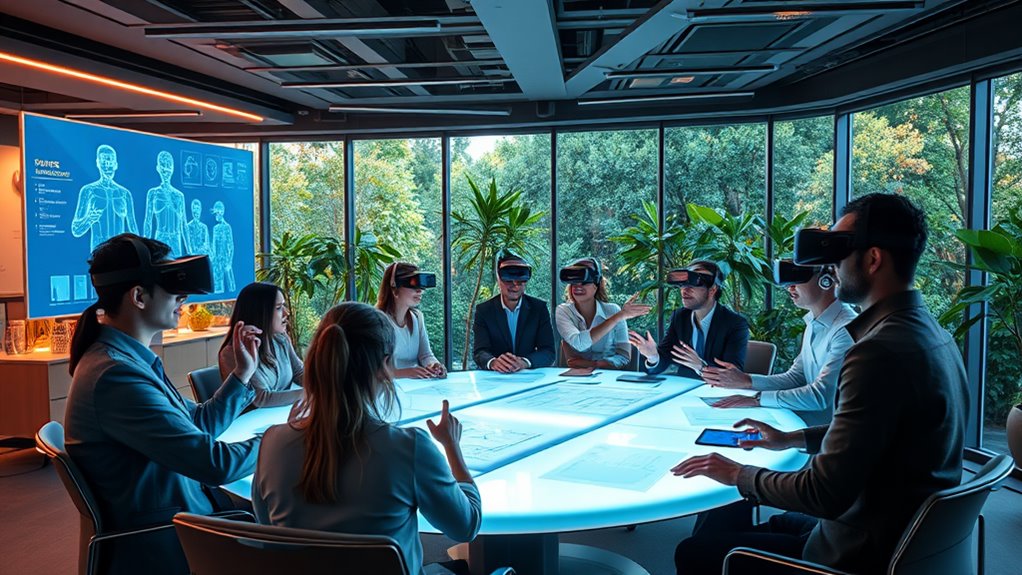
How can mixed reality (MR) transform collaboration in the workplace? MR serves as a bridge between physical and virtual environments, enhancing interaction among team members.
By integrating real-world and digital elements, it creates immersive spaces where employees can train and collaborate effectively. Accessibility is improved as MR can be used on devices like smartphones and tablets, reducing reliance on specialized hardware.
Businesses are increasingly adopting interactive virtual workspaces, which facilitate seamless communication and teamwork. The concept of virtual offices mimics physical spaces, allowing remote workers to engage fully in meetings.
Additionally, MR fosters real-time feedback and collaborative platforms that promote innovation through shared experiences. This adaptive technology tailors educational content, enriching skill-building opportunities for employees.
Overcoming Challenges to Widespread Adoption
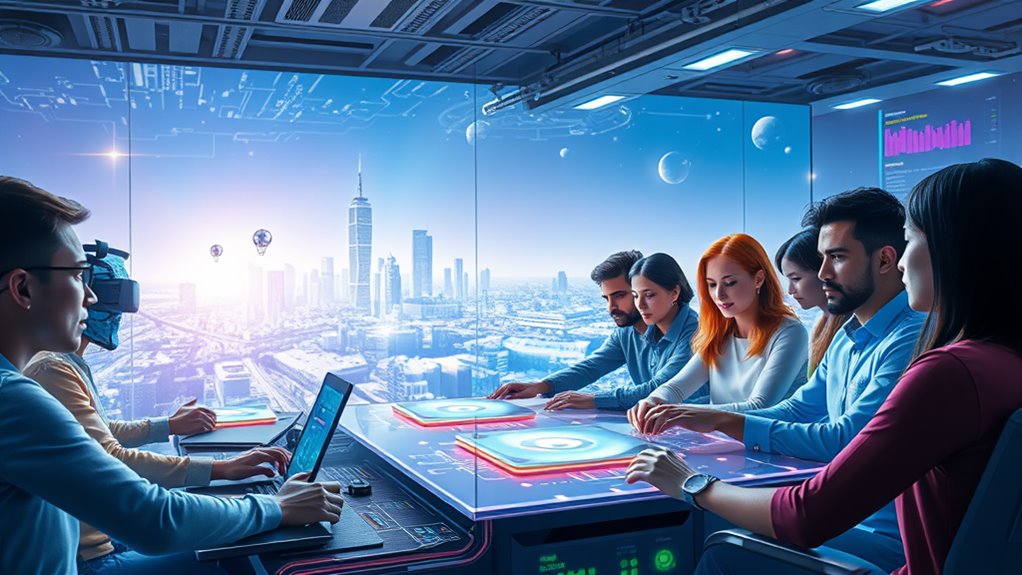
Adopting mixed reality (MR) technologies in the workplace encounters several significant challenges that organizations must navigate. These challenges include technological requirements for immersive experiences, user acceptance of MR as a legitimate workspace, and the need for effective virtual environment design. Additionally, security and privacy concerns, such as identity verification and data protection, cannot be overlooked. Organizations must also address social and cultural barriers to foster inclusivity and respect among diverse participants. Adequate training and upskilling initiatives are critical for preparing employees for new roles in the metaverse.
| Challenge Category | Key Issues | Potential Solutions |
|---|---|---|
| Design and Implementation | Technological requirements, user acceptance | Robust training programs |
| Security and Privacy | Data protection, identity verification | Strong cybersecurity measures |
| Social and Cultural | Diversity, social norms | Inclusive virtual environment design |
| Workplace Readiness | Upskilling, adaptation | Extensive reskilling initiatives |
| Regulatory Considerations | Lack of legislation, compliance | Development of legal frameworks |
The Role of Digital Infrastructure in the Metaverse

Digital infrastructure plays an essential role in the development and functionality of the metaverse, requiring significant investment to meet its demands.
Key components include the establishment of interoperability standards and addressing infrastructure challenges to guarantee seamless user experiences.
As the metaverse evolves, the integration of advanced technologies and robust systems will be vital for supporting its growth and enhancing economic opportunities.
Essential Investment Requirements
In the rapidly evolving landscape of the metaverse, robust digital infrastructure serves as a critical backbone for its success. Essential investments are needed to support various components, including data centers, network connectivity, and computing power. The following table highlights key investment areas:
| Investment Area | Description | Importance |
|---|---|---|
| Data Centers | Large facilities to process data efficiently | Essential for handling metaverse data |
| Network Connectivity | Advanced technologies like 5G | Enables real-time interactions |
| Compute and Storage | Increased capacity for processing and storage | Supports complex virtual environments |
| Energy Efficiency | Sustainable solutions to reduce consumption | Addresses high energy demands |
These investments will help guarantee that the metaverse can grow and provide immersive experiences for users.
Interoperability and Standards Development
As the metaverse continues to expand, the establishment of interoperability and standards development becomes increasingly important for its success.
Interoperability enables various technologies, such as augmented reality (AR) and virtual reality (VR), to work together seamlessly. This guarantees users can navigate different platforms without needing multiple identities or logins, enhancing their overall experience.
The development of consistent standards is essential for encouraging widespread adoption and fostering smooth interactions across various metaverse environments.
In addition, organizations like the Metaverse Standards Forum are significant in identifying current gaps in standards, promoting cooperation among tech companies, and establishing guidelines that support a unified digital infrastructure.
Such efforts ultimately contribute to creating immersive and interconnected virtual spaces.
Infrastructure Challenges Ahead
While the metaverse promises innovative experiences and enhanced digital interactions, it also faces significant infrastructure challenges that must be addressed to realize its full potential.
Increased demand for bandwidth is essential, as immersive experiences require substantial data transfer. Edge computing will be vital to reduce latency, ensuring seamless user experiences. The rollout of 5G networks offers a potential solution, providing higher speeds and lower latency.
However, the costs associated with hardware, software, and extensive data centers pose significant challenges. Additionally, legal and regulatory considerations, such as compliance with telecommunications regulations and data protection laws, will complicate infrastructure development.
Moreover, sustainability concerns regarding energy consumption and resource usage must be prioritized for a viable future in the metaverse.
Future Developments and Innovations in Work Dynamics
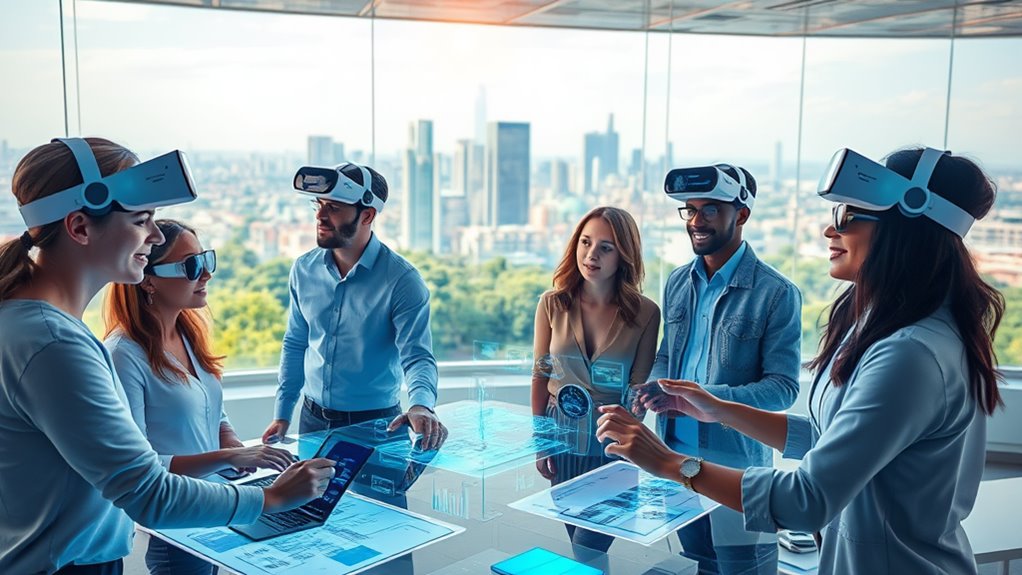
The evolution of work dynamics in the metaverse is marked by significant advancements in collaboration tools that reshape how teams interact and collaborate. These innovations lead to more dynamic virtual meetings, immersive training experiences, and increased flexibility. Companies are adopting virtual offices that allow for customized workspaces and real-time feedback mechanisms.
| Collaboration Tools | Training Innovations | Workplace Flexibility |
|---|---|---|
| VR/AR for team interactions | Immersive simulations | Customizable virtual workspaces |
| Avatars for meetings | AI-powered learning tools | Flexible work schedules |
| Global real-time feedback | Virtual mentorship | Increased accessibility |
As these changes unfold, businesses will need to adapt to new roles and improve employee skills to thrive in this evolving landscape.
Frequently Asked Questions
How Will the Metaverse Affect Work-Life Balance for Employees?
The Metaverse positively influences work-life balance by offering enhanced flexibility, eliminating commuting, and providing immersive remote work environments. These changes allow employees to better manage personal needs, ultimately improving their overall quality of life and reducing stress.
What Skills Will Be Most Valuable in the Metaverse Job Market?
The metaverse job market demands a blend of technical, creative, business, and soft skills. Proficiency in programming, VR technologies, storytelling, and adaptability will be vital for individuals maneuvering this evolving digital landscape.
How Can Companies Ensure Data Privacy in the Metaverse?
Companies can guarantee data privacy in the metaverse by adopting robust regulations, utilizing blockchain technology, implementing regular security audits, educating users about data practices, and maintaining transparent policies that empower individuals to manage their own data effectively.
What Impact Will the Metaverse Have on Workplace Culture?
The metaverse cultivates workplace culture by enhancing inclusivity, fostering diverse interactions, and promoting spontaneous collaborations. This immersive environment encourages engagement, nurtures connections among employees, and aligns digital presence with organizational values, ultimately transforming workplace dynamics.
How Will the Metaverse Change Employee Onboarding Processes?
The Metaverse transforms employee onboarding by offering immersive training experiences, fostering engagement through interactive modules, and enabling global participation. This innovative approach enhances cultural understanding and reduces stress, ultimately improving retention and overall satisfaction for new hires.
Conclusion
As the metaverse continues to evolve, the future of work is likely to undergo significant transformations. Businesses may find themselves charting uncharted waters, adapting to new technologies and work environments. Emerging job opportunities could reshape traditional career paths, fostering inclusivity and collaboration. However, challenges remain, requiring robust digital infrastructure and strategies for widespread adoption. Overall, the metaverse presents both potential benefits and hurdles, suggesting that organizations must remain agile to successfully embrace these changes.

